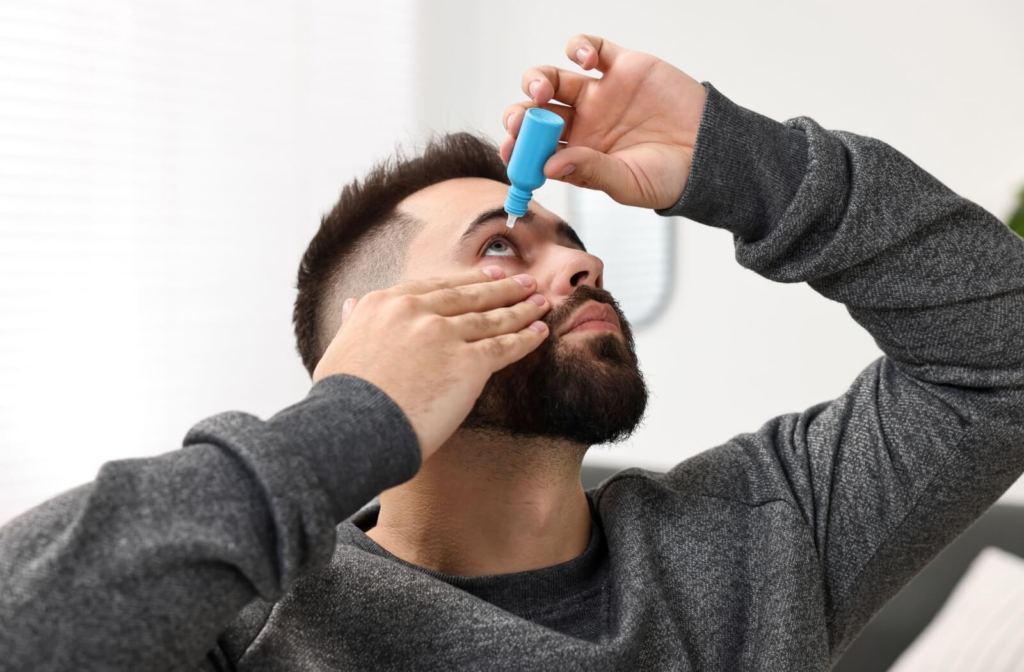Dry, irritated eyes can turn simple daily activities into uncomfortable experiences. If you’ve been dealing with persistent eye dryness, burning sensations, or that gritty feeling like sand in your eyes, clogged meibomian glands might be the culprit. These tiny oil-producing glands play a crucial role in keeping your eyes comfortable and well-lubricated.
From warm compresses and lid hygiene to IPL or RF therapies, there are several ways that you can unclog meibomian glands. Understanding how to unclog meibomian glands can provide significant relief from dry eye symptoms and help restore your eye comfort. If at-home remedies don’t provide relief, it’s a good idea to discuss your symptoms with your eye doctor, as they can provide personalized treatment and advice.
What Are Meibomian Glands?
Meibomian glands are special oil-producing glands located along the edges of your upper and lower eyelids. When meibomian glands function normally, they help maintain a stable tear film and comfortable vision throughout the day.
The meibomian glands secrete an oily substance called meibum every time you blink. This oil forms the outermost layer of your tear film, preventing tears from evaporating too quickly and keeping your eyes properly lubricated.
When these glands become blocked or dysfunctional, the oil cannot flow freely to the surface of your eye. This condition, known as meibomian gland dysfunction (MGD), is a leading cause of dry eye syndrome.
Common Causes of Meibomian Gland Clogging
Several factors can contribute to MGD and gland blockage:
- Age-related changes: These changes naturally reduce oil production and gland function over time. Hormonal fluctuations, particularly during menopause, can significantly impact gland performance.
- Environmental factors: External factors, such as dry air, wind, air conditioning, and excessive screen time, can worsen gland function. Digital device use reduces blink rates, which means less oil distribution across the eye surface.
- Certain medications and conditions: Over-the-counter and prescription medications, including antihistamines, antidepressants, and blood pressure medications, can decrease oil production. Skin conditions like rosacea and seborrheic dermatitis often coincide with meibomian gland problems.
- Poor eyelid hygiene: A lack of cleaning allows bacteria and debris to accumulate around gland openings, leading to inflammation and blockage. Contact lens wear and eye makeup can also contribute to gland dysfunction when not properly managed.
Home Remedies to Unclog Meibomian Glands
There are several things you can try at home for minor cases of clogged meibomian glands.
Warm Compresses
Heat helps soften hardened oil secretions and promotes natural gland drainage.
Specialized warm compress masks designed for eye care provide a more consistent temperature and the right duration of heat to help melt clogged oils in the glands. They’re also more convenient and effective than traditional methods.
If you don’t have a heated mask, a clean washcloth soaked in warm water can work in a pinch, though it typically doesn’t stay warm long enough to deliver the full benefits. To use, apply the compress to closed eyelids for 10–15 minutes, reheating the cloth as it cools. For best results, perform this treatment twice daily.
Gentle Lid Massage
After warm compress application, gentle eyelid massage helps express softened oils from the glands. Using clean fingers, apply light pressure along the eyelid margins, moving from the inner corner toward the outer corner.
Massage should be gentle to avoid damaging delicate eye tissues. Focus on areas where you can feel small bumps along the eyelid edge, as these can indicate blocked glands.
Eyelid Hygiene
Maintaining proper eyelid cleanliness prevents bacterial buildup and reduces inflammation around gland openings. Use preservative-free eyelid cleansers or diluted baby shampoo to gently clean eyelid margins daily.
Remove all eye makeup thoroughly each night, paying special attention to the lash line where glands are located. Consider using makeup remover specifically designed for sensitive eye areas.
Omega-3 Fatty Acids
Omega-3 fatty acids can improve oil quality and reduce inflammation associated with MGD. These essential fats help produce healthier, less viscous oils that flow more easily from the glands.
Fish oil supplements containing EPA and DHA are commonly recommended, though dietary sources like salmon, sardines, and flaxseeds can also be beneficial. Consult with your eye doctor about appropriate dosing for your specific needs.
Artificial Tears & Ointments
Artificial tears can provide immediate symptom relief while you work on unclogging your meibomian glands. Look for preservative-free formulations to avoid additional eye irritation.
Lubricating ointments applied before bedtime can provide extended relief, particularly for those who experience dry eyes upon waking. These thicker formulations may temporarily blur vision, making bedtime application most practical.

Professional MGD Treatments
When home remedies aren’t sufficient, several professional treatments can effectively address stubborn meibomian gland blockages.
INMODE Forma-I Radiofrequency
Forma-I radiofrequency treatment uses controlled thermal energy to heat the eyelid area, effectively melting hardened oil secretions within blocked glands. This noninvasive procedure typically requires multiple sessions for better results.
The radiofrequency energy also stimulates collagen production, which can improve overall eyelid health and function. Many patients experience significant improvement in dry eye symptoms following a series of treatments.
Lumecca Intense Pulse Light (IPL) Treatments
Lumecca IPL therapy targets inflammation and abnormal blood vessels that contribute to MGD. The light energy helps reduce inflammatory mediators and can improve gland function over time.
This treatment is particularly effective for patients with rosacea-related dry eye. Multiple sessions are typically required, with treatments spaced several weeks apart.
RESTASIS Eye Drops
RESTASIS (cyclosporine) is a prescription medication that helps increase natural tear production by reducing inflammation on the eye surface. This treatment addresses the underlying inflammatory component of dry eye disease.
Xiidra Eye Drops
Xiidra (lifitegrast) is another prescription anti-inflammatory eye drop that specifically targets inflammation associated with dry eye disease. It works by blocking inflammatory pathways that contribute to MGD.
Experience Comfortable Eyes with Personalized Treatment
Successfully unclogging meibomian glands often requires a combination of approaches tailored to your specific situation. While home remedies can provide an excellent starting point, persistent or severe symptoms may benefit from professional evaluation and treatment.
Remember that MGD is often a chronic condition requiring ongoing management rather than a one-time fix. Consistency with your chosen treatment approach will help yield the best long-term results.With the right combination of therapies, you can achieve significant improvement in your eye comfort and overall quality of life. Contact our team at Trail Vision Care Clinic today and book an appointment. You can also take our online dry eye quiz to help navigate your at-home dry eye relief efforts.




